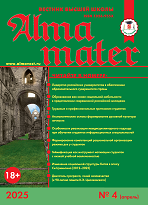UDC 331.5
https://doi.org/10.20339/AM.11-20.084
V.A. Gnevasheva is Dr.Sci. (Economy), Ass. Prof. , Head of Departament at Institute for Demographical Research, Federal Centre of Theoretical and Applied Sociology of Russian Academy of Sciences (IDR FCTAS RAS) e-mail: vera_cos@rambler.ru
Presented is the analysis of modern labor market, forming under influence of multiple factors. The conditions of the external global challenge put the labor market in need of transformation, sometimes in contrast to the economically rational distribution of the labor factor and with the depreciation of the social significance of the use of labor resources. Inequality and the widespread deficit of decent work lead not only to economic inefficiencies, but also to a decline in social cohesion within countries. At the
same time, the main goals of the strategic development of the labor market, such as: full employment and an increase in the standard of living, remain significant, and it is necessary to direct the efforts of governments, workers, employers and their associations. The emerging global trends of the world labor market pose a number of problematic issues for solving both at the level of national markets and on the world labor market together with international organizations in the framework of the global dialogue. The article provides a comprehensive analysis of the existing features of the distribution of labor and employment at the level of the world labor market, with the justification of such trends that are significant for issues of modern optimization of labor use, such as decent work, underemployment, structural unemployment, gender asymmetry, professional segregation, structural inflation, youth segment of labor market. All the phenomena under consideration are of a pronounced character both on the world and national labor market and require additional theoretical understanding and empirical assessment.
Key words: world labor market, decent work, underemployment, structural unemployment, gender asymmetry, occupational segregation, structural inflation, youth segment of labor market.
References
- World Employment and Social Outlook: Trends 2020. URL: https://www.ilo.org/global/research/global-reports/weso/2020/WCMS_734455...
- Abdryashitova, A.I., Zhilina, Zh.A., Illarionov, A.E., Kabanov, V.A. and oths. Comprehensive analysis in the development of a regional strategy. Vladimir, 2020.
- Aleshina, A.V., Bulgakov, A.L. Systemic risk. Economics of sustainable development. 2017. No. 1 (29). P. 20–27.
- Allagulieva, S.M. On the issue of internal labor migration in the Russian Federation. Higher School. 2016. No. 9-1. P. 68–70.
- Andreeva, A.A. The definition of the concepts of “external labor migration” and “internal labor migration” in the framework of sociological research. Theory and practice of social development. 2015. No. 8. P. 18–20.
- Andryushkova, E.A. To the question of the conceptual apparatus in the framework of the study of the problems of internal migration. Legal World. 2015. No. 15. P. 60–64.
- Bondarenko, I.A., Aslanova, O.A. Economic development and “failures” of the state. Bulletin of the Academy of Knowledge. 2020. No.1 (36). P. 30–35.
- Buzgalin, A.V., Kolganov, A.I. Planning in the economy of the 21st century: what and for what? Terra Economicus. 2017. No. 1. P. 29–43.
- Vakulenko, E.S. Econometric analysis of internal migration factors in Russia. Regional Studies. 2015. No. 4 (50). P. 83–95.
- Vysheslavova, T.F. The current state of internal labor migration in the Russian Federation. Historical, philosophical, political and legal sciences, cultural studies and art history. Problems of theory and practice. 2015. No. 6-2 (56). P. 50–53.
- Gayfutdinova, O.S. Internal migration as a factor in the innovative development of the territory (on the example of the Perm Territory). Economics of Entrepreneurship. 2015. No. 10-1 (63). P. 398–401.
- Women in the world of work: trends in 2016. Moscow, 2018.
- Ilyukhin, A.A., Ilyukhina, S.V. Social infrastructure and internal labor migration. Bulletin of St.-Petersburg State University of Economics. 2015. No. 3 (93). P. 20–24.
- Kazantseva, V.A., Lee, A.M. Internal labor migration to the Far East of Russia. Student Science of the 21st Century. 2015. No. 2 (5). P. 318–320.
- Kornai, J. Innovation and dynamism: the relationship of systems and technological progress. Problems of Economics. 2012. No. 4. P. 4–31.
- Mazhinsky, S.V. The influence of Han migration on the national identity of the Mongols of the autonomous region of Inner Mongolia in the middle of the 20th century. In: Man in a changing world. Problems of identity and social adaptation in history and the present: methodology, methodology and practice of research. 2015. P. 240–242.
- Matkerimova, G.T. On the issue of internal migration in the labor market of the Kyrgyz Republic. News of universities. 2014. No. 11. P. 86–88.
- Moiseenkov, A.A. Migration and internal security of the country. In: Modern science: theoretical and practical view. 2014. P. 204–205.
- Olson, M. The logic of collective action. Public goods and group theory. Moscow, 1995.
- The strategic development agenda. URL: https://www.un.org/sustainabledevelopment/en/about/development-agenda/
- Stiglitz, J. Information and the paradigm shift of economic theory. Ecovest. 2003. No. 3. P. 366–421.
- Tomask, A.G. Internal migration of the Republic of Sakha (Yakutia) and a social portrait of a rural migrant in urban settlements. In: Ethno-sociological Studies in the Republic of Sakha (Yakutia). Yakutsk, 2015. P. 23–43.
- Chernykh, A.A. The influence of internal and external migration on the regional economy. In: Regulation of innovative and integration processes in the Russian economy: problems, mechanisms, prospects. Penza, 2015. P. 78–82.
- Eldyaeva, N.A., Kovanova, E.S. Assessing the impact of internal labor migration on the socio-economic development of the region. Economics, Statistics and Informatics. Bulletin of UMO. 2015. No. 6. P. 106–111.
- Yasin, E. State and economics at the stage of modernization. Issues of Economics. 2006. No. 4. P. 19–24.











.png)






